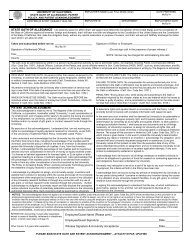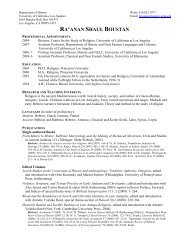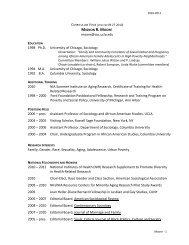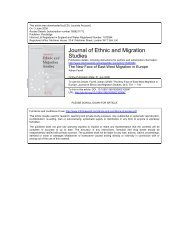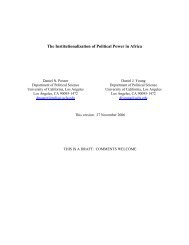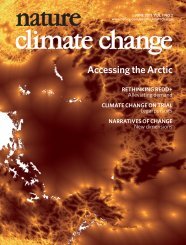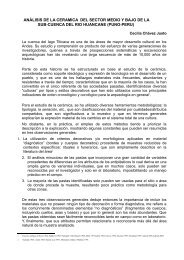The Long-Term Effects of Africa's Slave Trades - Social Sciences ...
The Long-Term Effects of Africa's Slave Trades - Social Sciences ...
The Long-Term Effects of Africa's Slave Trades - Social Sciences ...
You also want an ePaper? Increase the reach of your titles
YUMPU automatically turns print PDFs into web optimized ePapers that Google loves.
<strong>of</strong> coastline divided by land area, and countries’ endowments <strong>of</strong> gold, diamonds,<br />
and oil, measured by the natural log <strong>of</strong> average production per<br />
capita between 1970 and 2000. In columns 5 and 6, I include measures <strong>of</strong><br />
countries’ cultural characteristics. I control for the fraction <strong>of</strong> a country’s<br />
population that is Christian, the fraction that is Muslim, and for a country’s<br />
legal origin. In the final two columns, I include all <strong>of</strong> the control variables<br />
together, without and with the region fixed effects and colonizer fixed effects.<br />
23 In every specification, the coefficient <strong>of</strong> the slave exports variable<br />
remains negative and statistically significant. 24<br />
6 Examining Potential Channels <strong>of</strong> Causality<br />
Given that the evidence suggests that the relationship between the slave<br />
trades and current economic performance is causal, I now turn to the potential<br />
channels through which the slave trades may affect economic development.<br />
Motivated by the research <strong>of</strong> African historians, I test the potential<br />
channels <strong>of</strong> causality summarized in Section 2.2. <strong>The</strong> most likely channels<br />
are subsequent state development, ethnic fractionalization, and the quality<br />
<strong>of</strong> domestic legal institutions.<br />
When examining the effect that slave exports have on these factors, the<br />
question <strong>of</strong> causality remains important. If one finds a relationship in the<br />
data, it is unclear whether the slave trades affected this measure or whether<br />
the slave trades and the measure are both correlated with unobserved country<br />
characteristics. Here, I use the same instrumenting strategy that I used<br />
when considering the slave trade-income relationship. I use the distance<br />
from each country to the locations <strong>of</strong> demand for slaves as instruments.<br />
As I have shown, these measures were an important determinant <strong>of</strong> slave<br />
exports. More importantly, they are likely uncorrelated with initial characteristics<br />
<strong>of</strong> African countries that may affect subsequent state development,<br />
institutional change, or ethnic fractionalization, except through their impact<br />
on slave exports.<br />
In Table 8, I report IV and OLS estimates <strong>of</strong> the relationship between<br />
slave exports and variables that measure the different channels <strong>of</strong> causality.<br />
23 <strong>The</strong> only control variables that are consistently significant are the production <strong>of</strong> oil<br />
and the log <strong>of</strong> the coastline divided by land area. <strong>The</strong>se results are consistent with previous<br />
studies finding that oil production increases income (e.g., Easterly and Levine, 2003), and<br />
that natural openness increases income (e.g., Rappaport and Sachs, 2003).<br />
24 Although not reported here, the results also remain robust to the inclusion <strong>of</strong> additional<br />
geographic measures, such as elevation, temperature, humidity, rainfall, and frost<br />
days. <strong>The</strong> data are from Parker (1997).<br />
35




